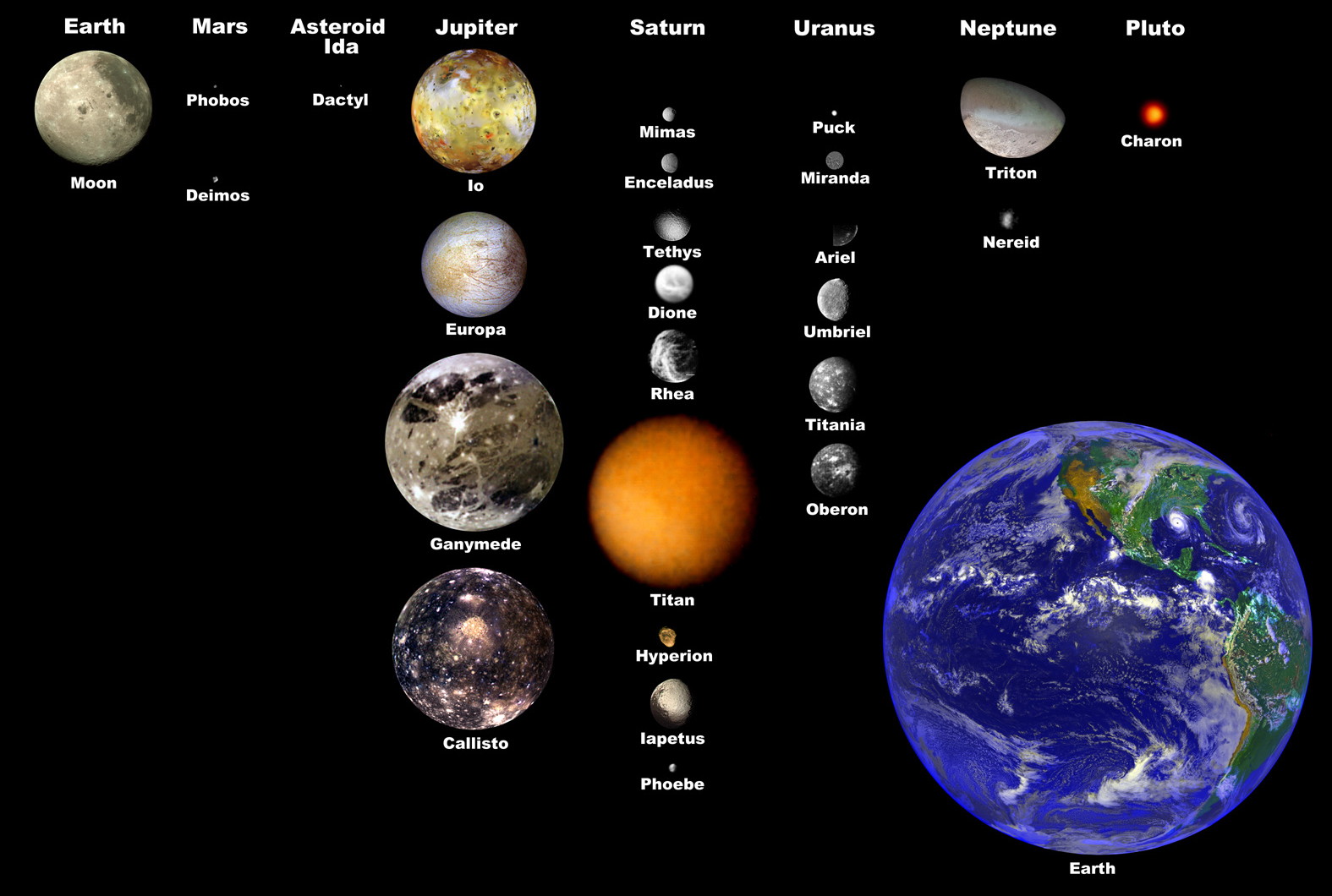Phobos and Triton are both natural satellites in our solar system. Phobos is a moon of Mars, while Triton orbits Neptune.
Each of these moons has unique characteristics and features that make them interesting objects of study. Phobos is the larger of the two, with a heavily cratered surface, while Triton is the seventh-largest moon in the solar system and has a thin atmosphere.
Understanding the differences and similarities between Phobos and Triton can provide valuable insights into the formation and evolution of moons and planets in our celestial neighborhood. We will explore the key attributes of Phobos and Triton, comparing and contrasting these fascinating moons to enhance our understanding of the diverse bodies that exist in our solar system.
Physical Characteristics
Phobos and Triton are two intriguing moons within our solar system, each possessing unique physical characteristics that distinguish them from one another. In this post, we will delve into their respective sizes, shapes, surface features, and more to gain a deeper understanding of these fascinating celestial bodies.
Size And Shape
Phobos, the larger moon of Mars, has an irregular shape resembling a potato, with a mean radius of approximately 11.1 kilometers. On the other hand, Triton, the largest moon of Neptune, boasts a more spherical shape with a mean radius of about 1,350 kilometers. These distinctive differences in size and shape set the stage for the vastly contrasting landscapes found on each of these moons.
Surface Features
Phobos’ surface is marked by grooves and crater chains, giving it a rugged and pockmarked appearance. In contrast, Triton’s surface is a remarkable blend of smooth plains, icy ridges, and impact craters, with expansive geysers spewing nitrogen gas and dark streaks created by cryovolcanism. The presence of these diverse surface features underscores the intricate geological processes at play on both moons.

Credit: pages.uoregon.edu
Composition
Composition plays a crucial role in understanding the similarities and differences between Phobos and Triton. Their internal structure and chemical makeup provide valuable insights into the formation and evolution of these moons.
Internal Structure
The internal structure of Phobos and Triton contributes to their unique characteristics. Phobos, being a moon of Mars, is believed to have a heavily cratered surface, indicating a rocky composition with a layer of regolith. On the other hand, Triton, a moon of Neptune, is thought to have a more complex internal structure, potentially featuring a combination of rock and ice layers, along with a subsurface ocean. These differences in internal structure may be attributed to the distinct geological processes that have shaped each moon over time.
Chemical Makeup
The chemical makeup of Phobos and Triton further distinguishes the two moons. Phobos is primarily composed of carbon-rich material, resembling a C-type asteroid, which suggests a similarity to the outer solar system’s primitive objects. In contrast, Triton is believed to have a significant presence of nitrogen, as well as traces of methane and carbon monoxide, indicating a varied composition influenced by volatile substances. These chemical distinctions highlight the diverse origins and environmental conditions that have influenced the formation of Phobos and Triton.
Orbital Properties
Phobos and Triton have distinct orbital properties. Phobos is one of Mars’ moons, with an irregular shape and orbits close to Mars, while Triton is Neptune’s largest moon, with a retrograde orbit and a unique surface featuring geysers. The differences in their orbital properties make them intriguing objects for planetary study.
Distance From Parent Planet
Phobos orbits around Mars, while Triton orbits around Neptune, both at varying distances.
Orbital Features
Phobos has a much closer orbit to Mars, with an average distance of about 9,378 kilometers.
In contrast, Triton is located at a significant distance from Neptune, approximately 354,759 kilometers away.
Atmosphere
The atmosphere of a celestial body plays a crucial role in determining its characteristics and potential habitability. When comparing Phobos and Triton, their atmospheres exhibit clear differences, affecting the overall conditions on each moon.
Presence Or Absence
Phobos, the larger and closer moon of Mars, does not possess a significant atmosphere. Its extremely thin atmosphere, consisting mainly of carbon dioxide, is barely detectable and lacks the ability to sustain life or affect the moon’s geological processes.
In contrast, Triton, Neptune’s largest moon, boasts a more substantial atmosphere. It contains a diverse range of gases, including nitrogen, methane, and trace amounts of carbon monoxide. Although the atmosphere is relatively thin, it extends outwards from the moon’s surface, contributing to its unique characteristics.
Composition If Present
If an atmosphere is present, its composition plays a fundamental role in determining the conditions on a celestial body. In the case of Phobos, with its limited atmosphere, the dominance of carbon dioxide results in an inhospitable environment characterized by extreme temperatures and a lack of resources.
On Triton, the mixture of nitrogen and methane in its atmosphere contributes to a wide range of notable features. The presence of nitrogen gives Triton a distinct blue tint, while the presence of methane contributes to complex weather patterns and potential cryovolcanism.
| Phobos | Triton |
|---|---|
| No significant atmosphere | Substantial atmosphere |
| Primarily carbon dioxide | Composition: nitrogen, methane, trace amounts of carbon monoxide |
| Extreme temperatures | Distinct blue tint, complex weather patterns |
| Limited resources | Potential cryovolcanism |
Understanding the presence or absence of an atmosphere and its composition provides valuable insights into the environmental conditions experienced on Phobos and Triton. While Phobos lacks a significant atmosphere and struggles with extreme temperatures and limited resources, Triton’s substantial atmosphere, composed of nitrogen and methane, contributes to its unique characteristics and potential cryovolcanic activity.
Missions And Exploration
Exploring celestial bodies helps us unravel the mysteries of the universe. Phobos and Triton, two fascinating moons in our solar system, have both garnered significant attention from scientists and astronomers. Let’s delve into the missions and exploration that have taken place in the past and the future plans that will further enhance our understanding of these enigmatic moons.
Past Missions To Phobos
Several missions have ventured towards the enigmatic moon Phobos, a natural satellite of Mars. Let’s take a look at some of the notable ones:
- Mars 2 and Mars 3: The Soviet Union launched these missions in 1971. Although Mars 2 crash-landed on the Martian surface, Mars 3 successfully captured the first images of Phobos.
- Phobos 1 and Phobos 2: These missions, also launched by the Soviet Union, were intended to land on Phobos and study its surface. Unfortunately, contact was lost with both spacecraft during their approach to the moon.
- Mars Express: Launched by the European Space Agency in 2003, Mars Express conducted detailed observations of Phobos. It studied the moon’s surface, composition, and internal structure, providing valuable insights into its formation and evolution.
Past Missions To Triton
Triton, the largest moon of Neptune, has also piqued the curiosity of scientists. Take a look at some of the missions that have explored this intriguing moon:
- Voyager 2: Launched by NASA in 1977, Voyager 2 provided us with our first close-up images and extensive data on Triton. It revealed cryovolcanoes, a thin atmosphere, and characteristic surface features, unraveling the moon’s complex geological history.
Future Exploration Plans
The exploration of Phobos and Triton is far from over. Scientists have outlined ambitious plans for future missions to uncover more mysteries hidden within these moons:
- Phobos Sample Return: NASA is planning a mission to collect samples from Phobos and return them to Earth for in-depth analysis. The insights gained from these samples could provide crucial information about the moon’s origin and composition.
- Triton Orbiter and Flyby: NASA has proposed a mission to orbit and conduct a flyby of Triton. This mission aims to study the moon’s atmosphere, surface composition, and potential subsurface ocean, shedding light on its unique characteristics and history.
As we eagerly anticipate these upcoming missions, the knowledge we gain from exploring Phobos and Triton will undoubtedly contribute significantly to our understanding of the solar system and beyond.

Credit: oldworldgods.com
Potential For Life
Conditions For Habitability
Phobos and Triton both show potential for life due to conditions favoring habitability.
- Phobos has a thin atmosphere with presence of water ice.
- Triton has active geysers releasing organic compounds.
Possibility Of Existence Of Life Forms
Life forms could potentially exist on Phobos and Triton, thriving in extreme conditions.
- Phobos could harbor microbial life beneath its surface.
- Triton’s subsurface ocean may support unknown microbial life forms.

Credit: tshirtslayer.com
Frequently Asked Questions For Phobos Vs Triton
How Does Phobos Compare To Triton In Terms Of Size And Composition?
Phobos and Triton differ in size and composition. Phobos is a moon of Mars, measuring only 22 kilometers in diameter, whereas Triton is the largest moon of Neptune and has a diameter of around 2,700 kilometers. Phobos is composed of rocky material, while Triton is made up of a mix of ice and rock.
What Are The Unique Features Of Phobos And Triton?
Phobos has unique features such as Stickney Crater, which is one of the largest impact craters in the solar system. Triton, on the other hand, has unique features like cryovolcanism, where geysers of nitrogen gas erupt from its icy surface.
These unique features make Phobos and Triton fascinating objects of study.
How Do Phobos And Triton Differ In Terms Of Their Orbits?
Phobos orbits very close to Mars, at a distance of only about 6,000 kilometers, making it one of the closest moons to its parent planet in the solar system. Triton, on the other hand, has a retrograde orbit, meaning it orbits Neptune in the opposite direction of the planet’s rotation.
Could Phobos Or Triton Support Human Exploration In The Future?
Phobos, being a small and rocky moon, could potentially serve as a stepping stone for human exploration of Mars. Its low gravity could make it easier for spacecraft to land and take off. Triton, with its unique cryovolcanism and icy resources, could also offer potential opportunities for future human exploration and resource utilization.
Conclusion
Ultimately, both Phobos and Triton offer unique characteristics in our solar system. Phobos, a Martian moon, exhibits unusual grooves and potential future missions. Meanwhile, Triton, Neptune’s moon, boasts cryovolcanoes and a retrograde orbit. Delving into their mysteries showcases the diverse wonders of our celestial neighborhood.



